Living on a nature preserve is certainly different than residing within a municipality such as Chelsea in Manhattan, but it's not without it's own society. At first I wasn't really conscious of the connection that the preserve created between myself and the many others who come to this land, whether for only a portion of one day out of their entire life, or as a regular user here on a frequent or even near daily basis.
Sure, I noticed others about me, and interacted with them on a variety of levels, but I didn't really understand that each and every one of us is part of this environment on a level not unlike those of a small town.
More than a hundred years ago, part of the Mohonk Preserve land holdings constituted at least one organized community, the Trapps Hamlet. Before that, it is known that natives to this area traveled across the Shawangunk Mountain ridges while on hunting expeditions and camped upon it's escarpments, at the very least. Of course, time continued and progress was was unstoppable. The Shawangunk berry pickers of the late 19th and first half of the 20th centuries, though a transient group, were the last to use this land as a way to subsist and survive, enjoying community amongst themselves as an integral part of that experience.
Nowadays, the Shawangunk ridge offers an extraordinary opportunity for nature lovers and those who enjoy outdoors adventurism. Climbers come from all over the world to challenge themselves on the steep cliff faces. Hikers, cyclists, photographers and naturalists mix with families here for a day of picnicking on the scenic grounds. And as the mission of the preserve unfolds, animals and plants native to this area once again have a habitat in which to thrive.
Look around! Chipmunks, squirrels, snakes, wild birds and even bears(if you are lucky enough to see one) on the preserve are glowing with vitality. The waterways are refreshingly clear, teeming with growth and healthy life. Plants, for the most part, survive their entire life without being trammeled into oblivion before having the chance to play their part in nature's cycle. The Mohonk Preserve is abundant with joie de vivre, and humans, understanding their place within this strata, intuitively take a submissive role to nature. For a fraction of our time on this planet we accept that we are not the dominate force.
Plants, animals, land, water, and the ever-changing weather cycles are the construct of this microcosm of our universe. Each element depends upon the others for survival, and the part humans play, though subordinate, is that of the steward. Without those people who populate Mohonksville to protect it, the land would be no different than any other scenic area available to the public at large; trashed forever by unfettered development, and polluted to a level where life is unsustainable due to a faulty system of checks and balances.
So – just who are the people of Mohonksville and what roles do they have within it's culture?
Most obvious would likely be those whom we see on a regular basis; the rangers, trail head assistants and volunteers with a public presence, such as those who lead hikes or assist guests at the Visitor Center. We might view them as representatives of the township of Mohonksville. Less known to the general public would be the administrators who must, by duty, spend much of their day sequestered within the offices of the preserve, and other places that often go unnoticed by most people. Without the efforts of those who serve on the Board of Directors, handle office responsibilities and provide maintenance services, Mohonksville would not be able to survive. These people constitute, to some degree, what would be referred to as civil servants within municipalities in the world at large.
Next we have those who use the land - Members, who amount to being taxpayers of a sort.. Some have more of a physical presence than others, but whether one takes up residence in Mohonksville by daily or near-so visits, comes only on the weekend or even a few times per year, these common citizens are the people in our neighborhood.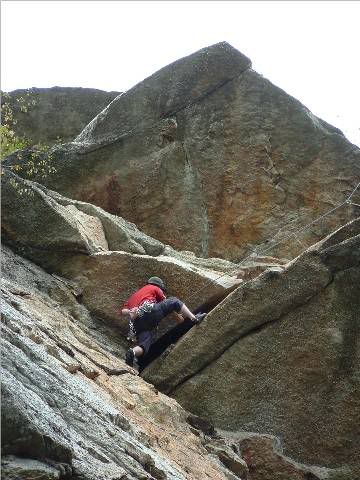
(Rock climber following "Inverted Layback" in the Near Trapps)
There are those who seem to be here always; the climber roping up in the Uberfall whenever we pass through, the hiker perpetually heading towards us on the trail each time we are out for a stroll, the nature lover who considers the Split Rock area part of their back yard, and lovingly tends to it's care on an almost daily basis by picking up cigarette butts and other bits of trash discarded by less meticulous individuals. We know these people by sight, if not always by name, and come to accept their presence at the preserve in the same way we expect to see the various rock formations, seasonal berries and wild flowers, and magnificent, colorful vistas of autumn foliage. They are, in perhaps an undefinable way, an integral part of the Mohonk Preserve, and when they are gone, their presence is missed
Other users constitute the majority of the human element within Mohonksville. These are the everyday people, those we see on occasion but perhaps never develop more than a passing acquaintance to, others who seem vaguely familiar if only due to the distinguishing characteristic that they walk with a rack of jingling climbing gear, roll by on a mountain bike, jog along the carriage road at the end of their canine companion's leash, or hike with a few children in tow. They inhabit the place, a constant system of rotation with similar folks. More of them abound on stellar weather days, but they do tend to blend together as a general crowd, much the way of sidewalk passersby.
And what would Mohonksville be without it's ebb and flow of tourists? In ways as much a destination spot as 42nd Street, the Mohonk Preserve is the crossroads of the universe to segments of the outdoors recreation world, particularly that of rock climbers.
These are people who visit irregularly, perhaps on a traditional yearly basis, but more often as a once or twice in a lifetime experience. They aren't familiar with the plethora of features everyone else seems to know: the Hairpin Turn, Steel Bridge, High E, Millbrook Ridge Trail, Duck Pond, the Stairmaster and downstream on the Coxing Kill at Split Rock, along with so many other landmarks. They get lost easily, even along roadways as uncomplicated for the locals as the Undercliff/Overcliff Carriage Road, and are often unable to distinguish the difference between the West Trapps and Warwasing parking areas. 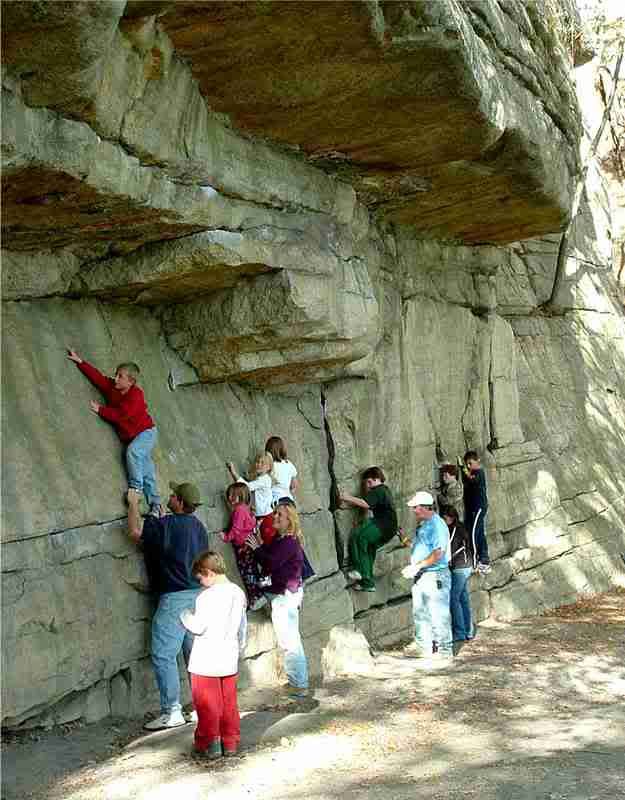
(They may be on the rocks, but these tourists are not rock climbers!)
Luckily for these travelers, the people of Mohonksville are almost always more than happy to point them in the right direction, provide beta on the classic climb they are desperate to get onto, or direct them to the area they left just minutes ago, to go to the bathroom or take a photo, and where the rest of their group awaits their return.
Tourists in Mohonksville are usually very pleasantly surprised at the subtle hospitality afforded them. Because of the governing policy of the preserve, they are often oblivious that there is, in fact, a social web that weaves throughout the place. In their mind, they've simply purchased a day pass to a nature preserve and are out on their own adventure. Like a visitor to any metropolis, they may go about their day seeing sights and experiencing sounds, all but unaware that other humans exist. This is, of course, by design, and befitting of the preserve's mission: to protect the Shawangunk Mountains by inspiring people to care for, enjoy and explore the natural world. For the one who comes here to commune with nature, there is no Mohonksville, since animals other than humans(so far as we know) do not follow our custom of naming their social collectives.
Of course, there is a social element devoid of humanity within this space. Else, how to explain the animal paths one occasionally comes across, or the gatherings of Canada Geese as they stop to rest and feed at Duck Pond? What about the papery wasp nests, cavernous abodes of aggressively swarming Ground Bees and columns of ants methodically transferring eggs from one locale to another - hundreds, perhaps thousands in number, all traveling back and forth along the exact same stretch of single-track trail? Certainly these shared spaces are indicative of a communal society.
As mentioned previously, humans take a subordinate role within this environment, proof that the preserve is successful in the perpetuation of it's mission. And so, since we know not what the animals(or plants, rocks and trees, should one consider they may have consciousness) might call this place, should they not be included within the construct of our Mohonksville? I certainly think so. After all, is not the small town park or downtown square an integral part of urbanized society?
So, along with our human neighbors, we include the Peregrine Falcons who make home high upon the cliffs as part of this social environment; perhaps even allowing them the prestige of celebrity status, as we watch in awe from afar, aware of their untouchability.
Each year pairs of the falcons mate, and within days of their nesting and egg-laying, announcements of the event are made. Word spreads throughout Mohonksville quickly, and soon enough even those not physically present are holding vigil, waiting for news on the number of hatchlings, and anticipating their first public appearance as if hooked on the weekly publishing of a favorite news tabloid.
Just recently a pair fledged, perhaps a bit too early. As sometimes happens, they did not complete their initial flight safely. Climbers came upon the pair amongst the talus above the Undercliff Carriage Road. One had already perished, and been preyed upon by an animal higher in the food chain. The other was alive, but injured. Preserve rangers were notified, and came to the aid of the injured bird, protecting them from further harm until qualified professionals could tend to it.
Like news in any small town, each person who found out about the incident excitedly conveyed what they knew to those they came upon, and within short order, seemingly everyone on the preserve was aware of the tragic event. By noontime, if one mentioned the accident to another, they already knew and possibly even had an update. On internet boards, people discussed the progression of events, anxious for positive news on the baby's welfare.
Birds are numerous, colorful and often providing cheerful song throughout the day. Owls alight at dusk and after, when the human element of Mohonksville has completed their daily migration away from the place.
Another set of creatures in our "town" bearing - forgive the pun - celebrity status, allowed plenty of personal space yet always excitedly spotted, would be those from our local bear population. 2010 has shown itself to be a big year for bears, and several sightings have been reported. As yearlings roam in search of territory to claim as their own, the rest of Mohonksville maintains a higher state of alertness, aware they are on the move and hoping to catch a glimpse of one.
Copperhead, Black, Rat and Water Snakes are frequently seen sunning themselves on talus slopes, slithering up steep rock faces with an ease that seems almost mockery to any climber who is watching their ascent, or gracefully swimming in ponds. Copperheads, though poisonous, are quite beautiful with their gold and brown patterned skin which helps camouflage them against the woodland floor of dried leaves and fallen branches. They're often viewed with both trepidation and disdain, not unlike the swarthy, handsome yet aloof, man about town the women warn each other after. Attractive – yes, but get close at risk of peril!
Mohonksville has quite a contingent of amphibians, insects, arachnids and other beings. Late spring brings out butterflies and moths. Dragonflies hover and cruise the grounds. Fireflies light up the woods each summer evening. Near waterways and amidst the forest floors frogs of several types spring into action whenever the tread of humans bumbling near enough seems threatening to their safety. Orange Efts dot pathways after a rainy day and Blue-tailed Skinks scamper and rock hop at the bases of cliffs. And Millipedes! Perhaps the most widely represented of Mohonksville's constituents, they are often held in contempt by subordinate humans, who have no idea whatsoever what their purpose is or why there are just....so many of them!
(Orange Eft)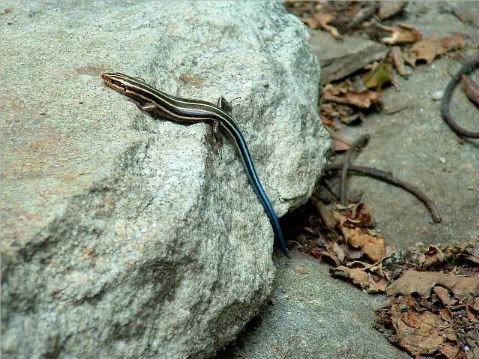
(Blue-Tailied Skink)
Life in our community is not limited to the animal kingdom. Trees, shrubs, ferns, flowers, berries, grasses, mosses and fungus are all an integral part of Mohonksville that only the unthinking would not include. The autumn season portends the coming of the human masses, in search of an easy sensory fix. Brilliant, densely saturated displays of colorful foliage create an aura of high festival season, and the land swells with an increase in tourist activity.
This may be peak time period for visitors to the area, but for those who know and love Mohonksville, it is but a short span within the cycle of seasons. After winter's hibernation period, dainty wildflowers begin to pop up in sunny patches throughout the preserve. In mid-May the regal Pink LadySlipper Orchid makes her appearance, stunning us with her stately majesty. Soon Mountain Laurel and Rhododendron are blossoming cliffsides, hills and vales, and blossoming bushes give way to wild blueberries, strawberries, black raspberries and grapes.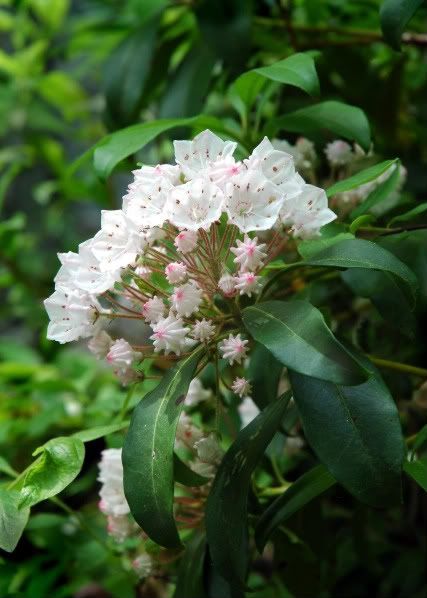
(Mountain Laurel)
Then there are the trees! Once culled nearly to decimation for timber, charcoal, barrel hoops, tannic acids and the clearing of pasturelands, the ridge is now in renaissance as Hemlocks, Pitch Pines, Birch, Oaks and others regenerate. Though likely the connection remains unmade by most autumn leaf-peeping visitors to Mohonksville, without the preserve, this land would be devoid of such splendor.
As well, the massive rock formations which the Shawangunks Ridge is famous for were at one time seen as a resource to be harvested. Millstones were quarried from the area, and sold down the river. One can find evidence of this old industry along the Trapps Hamlet Path and in other areas of the preserve.
Today, the rocks are still a highly valued asset, but most importantly their use is one with sustainability in mind. The ethical debate of bolting rock climbs was decided upon early, while war waged in other climbing destinations throughout the US. Here, bolts are use only for rappel anchors, and those are in favor of upholding the health and integrity of the cliff top trees. While a few bolts were placed on rock faces before the decision to ban their use was made, they are an anomaly to the tradition of using removable protection.
The Shawangunk cliffs are truly the foundation of Mohonksville society. From afar they are a beacon on the horizon, guiding human visitors the the area. In closer proximity, the escarpments provide an experience of a more visceral sort, whether it be the challenge to ascent a climbing route, a pleasant walk along their bases, or as a sublime vantage point to consider the scenic vistas throughout the acreage. More humbly, they are home to many – the plant and animal life of Mohonksville.
Surely I have neglected the mention of many others who make up the Mohonksville demographic. Feel free to leave a comment yourself, and include them in this description of our little town.
~~~~~~~~~~~~~~~~~~~~~~~~~If you enjoy my blog and would like to subscribe through RSS, you can click the FeedBurner Badge here. Thanks for your support! ![]() Subscribe in a reader
Subscribe in a reader






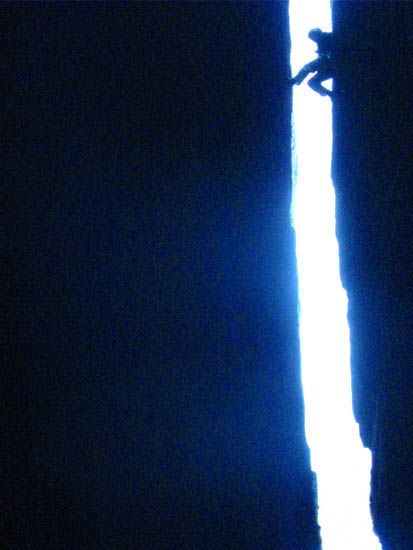
2 comments:
That climber on Inverted Layback is following, not leading. You can see the rope and pro above him, and none below him.
Thanks for catching that - my error.
Post a Comment